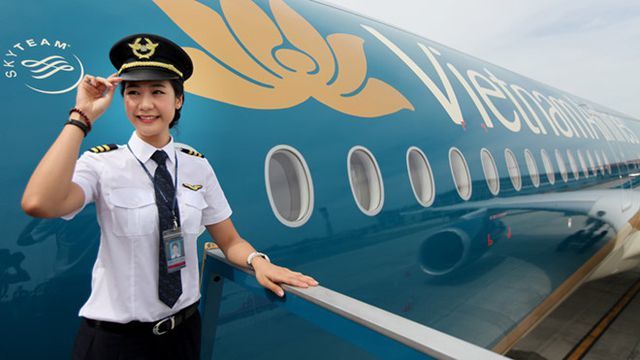Vingroup has joined hands with CAE Oxford Aviation Academy, to establish VinAviation School and VPA Training Center. The school begins enrolling students in August, and is expected that 400 pilots and mechanics will be produced a year.

Preparing human resources has always been a headache for Vietnam’s airlines for many years. While the aviation market is witnessing hot development, the number of pilots has not increased proportionally.
According to IATA, Vietnam has been one of the fastest growing aviation markets over the last decade with revenue growth rate of 17.4 percent per annum, nearly twice as much as that of Asia.
|
According to IATA, Vietnam has been one of the fastest growing aviation markets over the last decade with revenue growth rate of 17.4 percent per annum, nearly twice as much as that of Asia. |
A report of CAAV shows that from now to 2030, Vietnam will need 200 pilots more each year to satisfy demand for development.
However, Vietnam Airlines alone reported that the air carrier needed 193 pilots more in 2019.
Pilots cannot be trained domestically because Vietnam doesn’t have a training center. It takes at least three to four years of training for pilot to fly common aircraft such as Airbus A320, A321, and seven to eight years for Airbus A350, or Boeing 787..
However, it is expected that more pilot training projects will be implemented in Vietnam.
In late 2018, Vietjet Aviation Academy in the HCMC High Technology Park opened with initial capital of $170 million.
Vietjet Air reports that the academy has organized 924 training courses for 21,611 trainees, including 157 pilot training courses, 128 stewards and 128 engineer training courses.
The academy, in cooperation with Airbus, has put into operation flight simulation cockpit (SIM) and other modern equipment. By the end of 2018, the system had implemented more than 910 practice hours for pilots, Vietnamese and foreign, according to Vietjet Air.
Vietnam Airlines brought the first SIM to Vietnam last August. The air carrier said it has completed the localization of training of pilots for three key aircraft – A321, A350 and Boeing 787.
Vietnam Airlines also owns the pilot school Bay Viet, which was established in 2008. However, pilots still need to receive training overseas to be able to fly.
Bamboo Airways, the newly established airline, is also moving ahead with a plan to prepare its fleet. Though the number of air routes remains modest, Bamboo Airways continues to recruit captains, first officers and stewards. In June, the airline announced it will build an aviation training institute, possibly to be located in Binh Dinh province.
Linh Ha

Pilot shortage puts Vietnam’s booming aviation industry in trouble
Over the past few years, Vietnam’s aviation market has been sustaining a two-digit growth rate, while the introduction of new airlines has also put high quality personnel in the industry on high demand.

Vietnam Airlines pilot salaries continue rising
Vietnam Airlines pilots have seen a rise in their salary over recent years with the average figure of VND132.5 million (USD5,739) in 2018.
 The fleet expansion of airlines and the appearance of new airlines in the market have led to a pilot shortage in Vietnam.
The fleet expansion of airlines and the appearance of new airlines in the market have led to a pilot shortage in Vietnam.